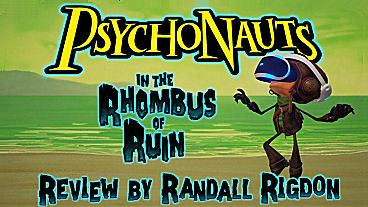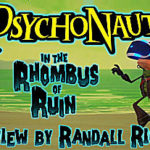
Psychonauts in the Rhombus of Ruin Review
A must-play for VR adventure gamers







Tim Schafer’s first VR adventure, PSVR-exclusive Psychonauts in the Rhombus of Ruin, is a welcome reminder of Schafer’s adventure game mastery, establishing the iconic game designer as a forerunner of the VR “look and click.” Of all of PSVR’s early offerings, Rhombus of Ruin is by far the most colorful, lighthearted and fun PSVR adventure game you can experience yet.
I haven’t played Psychonauts since it was first released, so a lot of minor details had slipped my mind. But as soon as Rhombus of Ruin began, the familiarity of its tone and funny characters quickly settled in, which speaks to the long-lasting effect of the original’s memorable world, great characters and clever writing.
If you have not played the original game, you’re certain to lack some intimacy with the characters and understanding of who they really are, especially considering a big goal of Psychonauts is to uncover the deep-seated, personal stories inside of a character’s head and to use it against him.
Fortunately, Rhombus of Ruin‘s premise is simple enough that hefty character exposition is entirely skipped over, as at its core, you’re Raz, a young mischievous boy with psychic powers who’s traveling with other psychic spies of the Psychonauts team. Raz is joined by levitation expert and groovy fashionista agent Milla Vodello, the famous German psychic Sahsa Nein, the militant but lovable Coach Morry, and Raz’s potential new girlfriend Lili Zanotto, although they’ve not yet discussed their romantic status despite recently kissing.
Raz’s character (played by phenomenal voice actor Richard Steven Horvitz of Invader Zim and Angry Beavers fame) as well as the surrounding characters are funny and quirky enough to engage a newcomer straight into the scene. You’re not here for deeply-layered mystery or complex character development (though some of it is here); you’re here because of the vibrancy of Schafer’s universe and creative mind-bending puzzles. And PSVR delivers this in a way Schafer’s work has never been felt or experienced before.
Taking in Schafer’s world in an actual 3D space punctuates Schafer’s uniquely stylized vision in a way that reminds me of the visual cohesiveness and twisted uniqueness of director Tim Burton. In one scene, I found myself staring off at a light bulb hanging in the corner of the scene. Obviously, in VR, the light bulb felt as if it were actually draped above my head in actual physical space, but I also found myself captured by its rustic and slightly cartoonish look that only could arise from a Shafer production. It’s a tiny detail dramatically intensified in the realm of VR, exemplifying the detailed framing Double Fine painstakingly slides into their productions that would normally otherwise go unnoticed.
The adventure begins on a spaceship with your psychic cohorts that instantly strikes some serious ’70s psychedelic vibes through the VR headset. The only things missing from the trippy, stretchy stereoscopic look of the bouncy, Sean Connery-era Bond spaceship interior with vinyl records, floating chrome chairs and throw pillows scattered about are a lava lamp and a shag carpet.
Now, the game works primarily in a first-person stationary effect where you can look around but can’t walk around. This initially seems very limiting until you realize the navigation is done through jumping through other sentient character’s minds in the environment. You simply look at a character, press square, and you’ll fling from the first person view of one character’s head, right into the head of the next selected character. This allows for an extremely interesting VR and puzzle mechanic, which Schafer and company manage to utilize in every way imaginable in a two to three-hour span.
For example, the game rather abruptly jumps from this trippy spaceship environment to its primary, near Bioshock-esque underwater, secret layer scene. navigating the ocean becomes a matter of finding strings of swimming fish and jumping from one fish-mind to another, cleverly maneuvering yourself through sunken machinery and bubbling, floating ruins from the unique perspective of each creature in the water.
This mechanic is an immense joy in which to explore and experience the environment scene-to-scene, finding brilliant first-person perspectives from multiple characters and creatures wherever you can find them. It also allows for some pretty silly moments which the writing brilliantly capitalizes on, such as jellyfish that “for some reason” have humanoid brains allowing you to warp and travel through them, or a hilarious “staring contest” moment that mocks an awkward staging of stationary characters. It’s simply an enormous joy to look around the environment, warp instantly into the mind of a nearby creature, and view that same environment from an entirely new and different way to solve puzzles from every angle.
In every perspective, Raz also brings a set of psychic skills essential to solving every puzzle. This always feels uniquely satisfying and oddly authentic through the use of head tracking with the headset. For instance, the heat vision feels as though there’s a literal beam of heat projecting from your head wherever you look while holding down triangle; this is also true when you look using telekinesis (L2), which flings and flies objects around. This will be the most authentic game of pretend physics you’ve ever played within your own head.
Fortunately, Rhombus of Ruin doesn’t miss a beat to fire some serious VR punches. Early on, in a moment that truly reflects the ’70s vibe, a bright orange stereoscopic heat warping effect overlays in your headset in scenes when you teleport. This seriously hit me with a hard nostalgic feeling of looking at a brightly colored, plastic-like layered image in a toy viewfinder.
Another special VR moment involves a close and funny face-to-face moment with Raz and Lilli. Seeing Lily’s huge, wide-eyed towering noggin right in your face is a quite an awkward and funny delight, and the scene is quickly followed by a similar closeup on Lily’s pet rats face, the 3D proximity effect of which made me cringe backward in disgust.
The puzzles themselves are fun, smart and never frustrating. In my personal opinion, Schafer puzzles in the past could be a little hit or miss. In Day of the Tentacle, I found the puzzles amazingly balanced. In Grim Fandango, I found the puzzles a little more all over the map. In Rhombus of Ruin, the puzzles are more Day of the Tentacle-style in that they’re never random and are very logical, but usually require unique thinking within the comical and mind-bending context of the game.
For instance, one scene involves helping Lily navigate through a series of floating train cars from a distance. The goal of the puzzle is very straightforward and easy to understand but requires some out-of-the-box thinking. You must determine the correct fish into which you must mind-warp in order to utilize the most appropriate psychic ability from the most appropriate angle to remove the object obstructing Lilly’s path on the train car.
There were a few moments during which I was more or less stuck in a room for a few minutes trying to figure out what to do next. But since I was in VR and the environments were so beautiful to explore, it was easy to be immersed in the world-building while not banging my head against the wall finding a solution to the problem at hand. This usually ended in finding an obvious manipulative object in the environment I had not noticed before, followed by a heavily-relieved “duh!!”
Aside from the wondrously detailed and vibrant environments, as well as characters and puzzles all creatively utilizing the potential of VR with lots of 3D layers, there are one or two things that don’t allow Rhombus of Ruin to be a perfect game. For instance, a couple of the scenes where I was stuck for a few moments had endlessly looping lines of dialogue that would break the immersion and slowly drive me a little crazy. Double Fine should really go back and patch some of these lines not to repeat endlessly because the detail in the environments and the wonderfully relaxing music alone are enough to pacify players while they seek a solution.
Additionally, the game is fairly short. Ultimately, it clocks in at around 3 hours. If the game had maybe been another hour longer it would have felt like the complete package. Unfortunately, at its current running time, it feels like a near-complete standalone title, being a smidgen above being a quaint teaser title for the fuller upcoming sequel.
Regardless, I did really enjoy the final sequences and the funny ending, tying the story together in a fun and rewarding way, even playing with my emotions and expectations one last time before the final reveal.
Rhombus of Ruin is a critical point for the future of VR adventure games. It’s a pinnacle for the “look-and-click” evolution of the point-and-click genre, showcasing that VR can pioneer and advance an old framework into something new when the right team gets behind the technology. Double Fine is the first to step up to that plate with Rhombus of Ruin, showcasing that traditional point-and-clickers, or rather look-and-clickers, can actually be the genre that defines the VR revolution. A must-play for VR adventure gamers.
|
+ Fantastic use of VR brings Schafer’s vision to life like it never has before
+ Brilliantly creative mind-hopping navigational puzzle mechanic
+ Great voice acting, great characters, great writing
– Some repeated endless loops of dialogue break game immersion
– Could have been an hour longer
|
 |

Leave a Reply